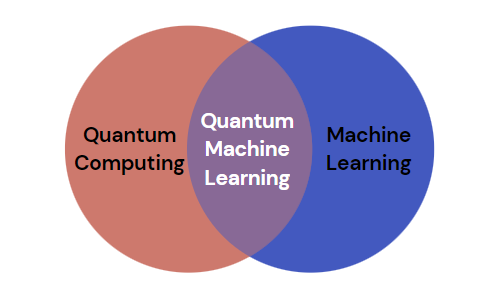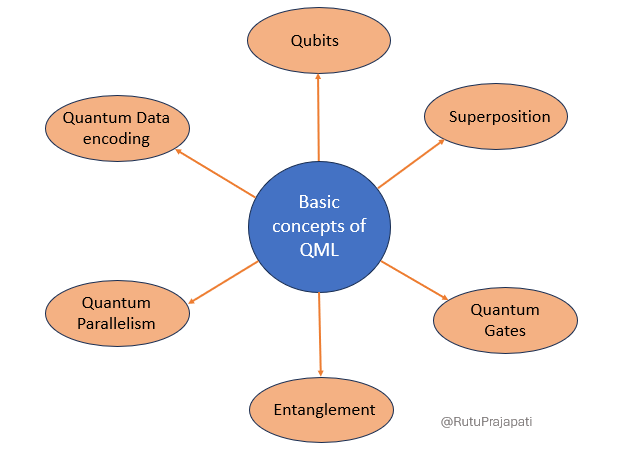Understanding Quantum Machine Learning (QML)
 Rutu Prajapati
Rutu Prajapati
1. Introduction
Imagine a world with me where computers are not just smart, they are quantum smart. This is an interesting reality of Quantum Machine Learning. I found this topic very interesting and worth knowing, and that's why I'm writing this blog to share what I found out about QML and how amazing it is.
I hope you find this blog interesting and helps to improve your knowledge.
To shape the future of computing, let’s understand how quantum computing and machine learning work together. It is a theoretical field that is in the starting phase of development.
2. What is Quantum Machine Learning (QML)?
You may be wondering what QML is. Let me tell you what I learned. Quantum Machine Learning is like a combination of quantum computing and machine learning. Quantum algorithms solve machine learning problems using quantum computing. They can work faster and better than the regular computer programs that we use for machine learning.

Let’s take an example – classify images of cats and dogs.
Regular Approach (Classical machine learning):
In classical machine learning, we would train a model by giving labels that recognize images of cats and dogs. The model will learn by features and patterns to differentiate cats and dogs. When we want to classify a new image as a cat or a dog, the model goes through each feature one by one, compares them, and decides based on that.
Quantum–enhanced approach:
Now, a quantum computer uses qubits (quantum bits) to process information. Quantum algorithms can process multiple possibilities at a time, using a property called superposition. This means they can consider both cat and dog features at the same time. So, when we give an image to a quantum-enhanced machine learning algorithm, the quantum computer looks at different parts of the image all at once and finds patterns very fast, this helps in decide whether it's a cat or a dog. It is an advantage of quantum-enhanced machine learning over classical methods that it can solve problems with more efficiency.
This shows how quantum-enhanced techniques can do tasks at a speed that classical computers can't. In real life, quantum machine learning can help us to solve problems much faster than traditional methods.
3. Merging Quantum and Machine Learning
Machine Learning finds patterns in data. It makes predictions and makes decisions.
Quantum computing uses the principles of quantum mechanics to perform calculations.
The motivation behind QML is to increase the performance and capabilities of machine learning algorithms by properties of quantum computing.
4. Basic concepts of QML
Let’s know more by understanding the below properties,

Qubits: Qubits stands for quantum bits. Qubits/quantum bits are the fundamental units in quantum computing. Binary bits have only two states 0s and 1s where qubits can have multiple states at the same time. Qubits can perform certain types of calculations much faster than classical bits.
Superposition: Qubits can be in multiple states at a time. This is called superposition where multiple calculations can perform in parallel.
Quantum gates: Quantum gates are similar to classical logic gates. It is used to perform operations on qubits. They manage the quantum state of qubits. Also enables complex calculations.
Entanglement: When two or more qubits correlate such that, the state of one qubit cannot be represented without the state of another qubit is called entanglement.
Quantum parallelism: Because of superposition, Quantum computers can perform multiple calculations simultaneously which can speed up algorithms is called quantum parallelism.
Quantum Data encoding: It converts classical data (which exists as binary digits 0s and 1s) into the quantum state (represented by qubits), that can be used by quantum algorithms.
5. Quantum machine learning algorithms
These algorithms make QML more efficient. Here I covered some of them,
Quantum Variational Circuit:
It solves problems by quantum circuits. It encodes the problem into the quantum circuit and updates the circuit parameters to find the solution.
Quantum Support Vector Machines (QSVM):
QSVM is like a classical support vector machine algorithm(SVM). It speeds up the SVM algorithm.
Quantum Neural Networks (QNN):
Quantum neural networks are like classical neural networks, but they use quantum gates and qubits for calculation. It can be used in data classification, regression, and feature learning. They can identify quantum correlations in data.
Quantum k-means clustering:
It uses quantum computing to cluster data points. It can be used in finding patterns and groups in data by quantum parallelism.
6. Applications of QML
QML can be used in:
Drug discovery and molecular simulation
Cryptography and Security
Financial Modelling
Pattern Recognition and Data Clustering
Quantum-enhanced Machine Learning Models
Quantum-enhanced Reinforcement Learning
Artificial Intelligence Hardware Development

Quantum machine learning can reshape approaches to problem-solving, and open new methods for discovery & innovation also can impact industries.
7. Challenges and Limitations
Though QML is better, it also has limitations and challenges,
Quantum algorithms require specialized software development tools.
Quantum data is currently limited in availability.
Techniques for generating and processing quantum data are still evolving.
Designing efficient quantum circuits is challenging.
Quantum computing infrastructure and resources are expensive and not widely available.
Quantum superposition allows qubits to be in multiple states at a time, but this property diminishes as qubits interact with their environment. As algorithms become more complex, maintaining superposition becomes challenging.
8. Conclusion
Here, we saw what QML is, how ML and quantum computing merge, properties like qubits, superposition, Entanglement, Data encoding etc., some algorithms, applications and challenges. Now we have an idea about QML, we can see that in the future, it can impact many fields. What do you think about QML?
Subscribe to my newsletter
Read articles from Rutu Prajapati directly inside your inbox. Subscribe to the newsletter, and don't miss out.
Written by
